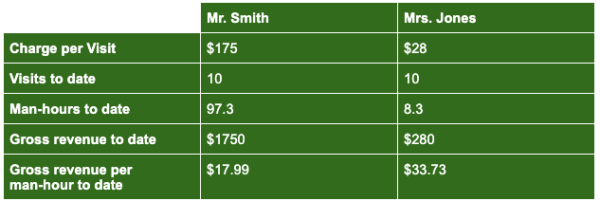Accurate job costing is the single most important factor in determining your lawn maintenance business profitability.
Hey Clippers! We’re here to talk about a surprisingly polarizing topic: Job costing. Some people love it, some people hate it. But feelings aside, accurate job costing can make a huge difference in your profit margins.
Let me start by saying that this article serves as an introduction to job costing. I’m going to do my best to give you a useful overview. But if you want to go deep, I’d recommend signing up for a seminar or a workshop.
Job costing is putting a concrete number on what it costs you to perform a certain job. In the lawn maintenance world, you’re more likely to lose money on labor than materials. So we’re going to do a lot of math around man-hours and timing.
Let’s get started by writing down some base numbers:
- How many productive workers do you have?
- How many hours per week do they work?
- How many weeks per year do they work?
- What are your total yearly costs?
- What is your desired profit margin?
We’re going to use these figures to calculate the number of gross dollars per hour your employees need to generate to cover expenses and profit margins. This number is your key to identifying which jobs are earning you a profit—and which jobs are costing you money.
Now apply the formula to your business
I’m going to put some example numbers into a table to show you how the math works. You should recreate this calculation with the numbers you wrote down.
- Add up your annual costs and desired annual profit, and write the total in column A.
- Fill out columns B, C, and D.
- Multiply the numbers in columns B, C, and D, and write the outcome in column E.
- Divide column A by column E. Write the outcome in column F.


That number in column F is the bare minimum you need to earn per hour to cover your expenses and meet your profitability goals.
Now you’re going to use this number to do an audit on all your jobs. This exercise is an excellent argument for the benefits of meticulously tracking all your jobs. You should have updated data on man-hours and gross revenue for each property in your customer database.
Here’s how the math works. You’ll plug in the numbers from each of your properties to do this.
Number of man-hours to date / gross revenue to date = actual man-hour rate
This is where it gets interesting.
A lot of people assume that the better job is the one with a higher price tag, but that’s not always the case. Time for another example. Let’s compare two hypothetical customers:

At first glance, you’d think Mr. Smith is the more valuable customer, right? But I’m sure you know there’s a bait-and-switch coming. Let’s say you print a job-costing report at the end of the season, plus data on all the man-hours worked.

Take a look at that bottom row. Now who do you think is the more valuable customer?
If your desired gross revenue per man-hour is $24.69, you’re losing money on Mr. Smith’s account. In fact, you’re only staying afloat because of the extra revenue coming from Mrs. Jones.
Here’s the punchline: You can’t know this unless you’re keeping good records and printing regular reports. I know it might seem tedious, and there are moments when it certainly feels that way. But you stand to lose a lot of money if you’re not keeping a close eye on these numbers.
Use job costing to improve your lawn maintenance business profitability
We were once approached about doing lawn maintenance for a dog run in town. We got a little starry-eyed over the big paycheck at first. But we ran a job-costing report and realized the math didn’t work out. Even with that big paycheck, we weren’t making enough money per man-hour to be profitable. We were turning a way bigger profit per man-hour on residential properties. So we turned down the job.
We’ve talked before about the fact that you manage what you measure, but first, make sure you pick the right jobs.
The point is, job costing can make it easy for you to immediately spot the most and least profitable jobs. Once you know where the money is, you can focus your energy and marketing there. No more scratching your head and wondering where all your money went.
Lawn maintenance is a predictable and manageable line of business. That’s why I love it so much. And you can make it even more streamlined by embracing the power of job costing.

